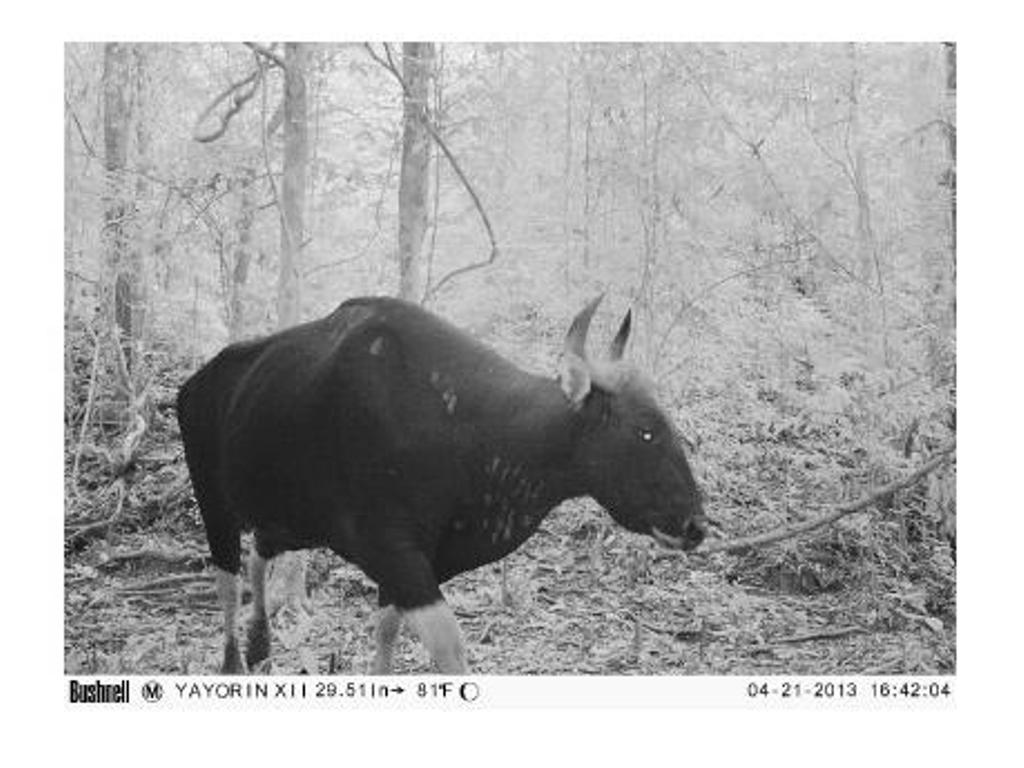by Editor : Yunanto Wiji Utomo
JAKARTA, KOMPAS.com - forest conservation organization, Yayasan Orangutan Indonesia, prove the existence of a bull in the wilds Belantikan Kalimantan, Central Kalimantan. Recent evidence is a result of the presence of surveillance cameras that captured the protected fauna are active in the region nonkonservasi.
"These findings should awaken us all about the importance of protecting forest ecosystems outside the conservation area," said Eddy Santoso, Executive Director of Yayasan Orangutan Indonesia (Yayorin), Sunday (14/07/2013), of Pangkalanbun, Central Kalimantan.
Visually proving the existence of a bull Kalimantan is the first time. Previous years, the bull only known to exist of the footprints and droppings on Hulu Belantikan.
Eddy explained, it seeks to assure the presence of Borneo banteng (Bos javanicus lowi) by installing surveillance cameras (camera traps). Activities carried out during the period 2012-2013 with funding Yayorin U.S. Fish and Wildlife Services in Belantikan.
"From some of the shots captured photo images in groups or solitary bull," said Eddy. Herd of bison observed in the mineral region in the middle of a forest called politeness (salt lick). Politeness to the indigenous territories.
Among the 25 who recorded politeness, two great politeness great potential as a herd bull, ie politeness politeness salinity and sandy. "It strengthens the evidence no bull population in Hulu Belantikan Kalimantan, Lamandau district," said Imam Sapari, researchers Yayorin.
Admittedly, the findings are very preliminary and challenge scientists, researchers, and conservationists to proceed with a comprehensive review. "There is still ongoing research is needed, especially for population monitoring, well socialized to people familiar with the typical wildlife Belantikan are reserved," said M Yunus, researchers Yayorin.
 |
| Kalimantan bull caught by a camera mounted researchers Yayasan Orangutan Indonesia, in the upstream Belantikan, Lamandau, Central Kalimantan, some time ago. The findings are outside the conservation area. It is a reminder of the importance of protecting outside of protected areas. | Yayorin |
Outside the protection area
According to Eddy, the key protection is the involvement of the owner of the bull Kalimantan concession license for utilization of timber forest products (IUPHHK) in the protection of endangered species and activities outside the protected conservation area.
"The next challenge, finding a combination of forest concession permits whose location is located in areas that are very important for the animals that have protected status, and need to increase cooperation, sense of responsibility, and a firm commitment to implement area management, habitat, and wildlife sustainable area of operations and supporting livelihoods of local communities, "says Eddy.
Kalimantan bull findings indicate that many actually protected fauna living outside conservation areas. Previous studies indicated through traffic dispersion and wildlife such as orangutans, Sumatran tigers, and Sumatran elephants.
Hulu Belantikan region is lowland forest remaining in Central Kalimantan and is currently a limited production forest timber and mining companies. Belantikan landscape of the region began to Arut Belantikan Perai and Bukit Bukit cavity in West Kalimantan area of approximately 500,000 hectares.
Belantikan has a population of orangutans (Pongo pygmaeus wurmbii), the largest outside the conservation area. Besides orangutans, Belantikan also live in a variety of important flora and fauna, including bison Kalimantan.
Indication of bull Kalimantan orangutan obtained while researching team in 2005. They found the trail and dirt around politeness which corroborated the information about the area.
Since traces of it, is not known where the bull population Kalimantan. Amplifier is limited to information resources of local communities. Current information and distribution of animal populations that entered the red list of International Union Conservation of Nature (IUCN) as an endangered species (endangered species) is not known with certainty.
The discovery of a bull activity footprints and droppings also occurred on 20 November 2007. The research team found two bull footprint, each measuring 12 cm x 11.5 cm and 14 cm x 13 cm, around clumps of bamboo in the region of Bukit Durian, one of the tribal areas in the Village Kahingai. Expected, it was a male and female bull trail.
In 2010, the community found a young bull, was later found also a large male bison crossing the river around the village Kahingai.
Since 2010, the data Yayorin become boosters for conservation action plan for wild cow (bull) by the Directorate General of Forest Protection and Nature Conservation in the years 2010 to 2020 which stated Permenhut 58/Menhut-II/2011 Number.
Yayorin with its partner, Orangutan Foundation and the Natural Resources Conservation Agency of Central Kalimantan, has continued to trace the bison population in Hulu Belantikan. (Ichwan Susanto / Reuters)
Tidak ada komentar:
Posting Komentar